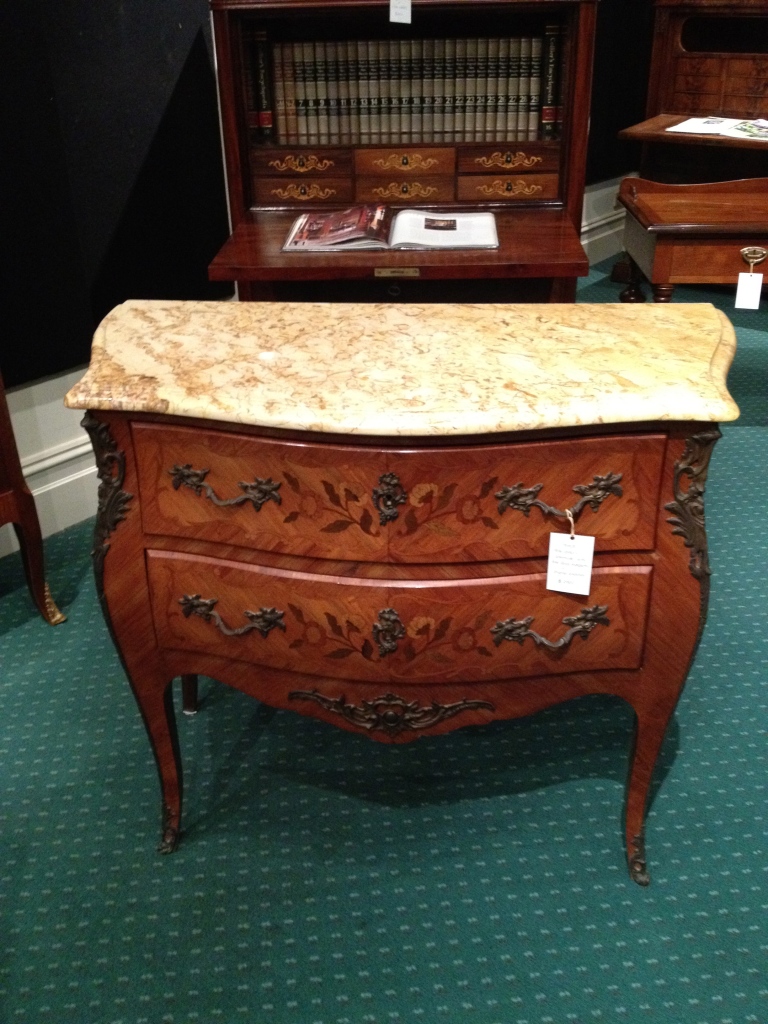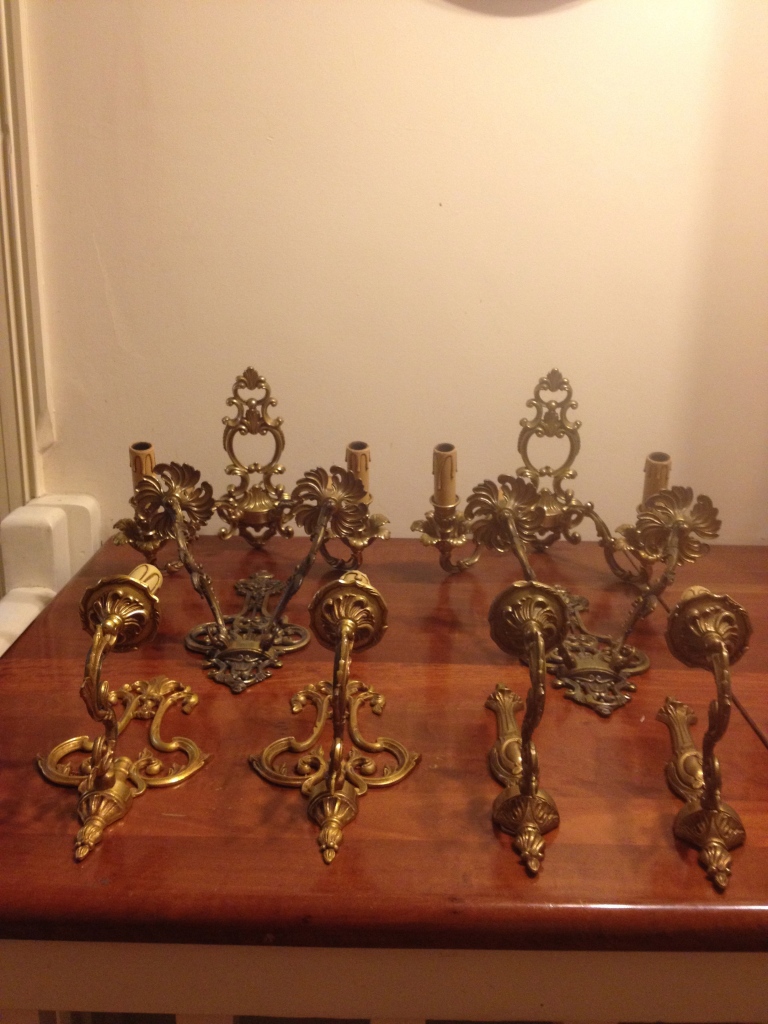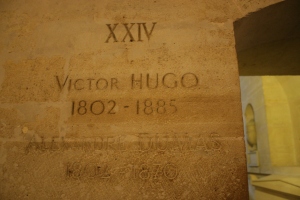We were up at some ungodly hour this morning. It was time for mum and dad to head back to Malaysia. Hubby and I were staying for the rest of the week. After his bad experience on the RER, dad was flat-out refusing to take it again back to the airport. In the end, we offered to accompany mum and dad to make sure they got on the right RER. Because we had luggage, we decided to take Métro Line 4 at St-Michel instead of walking all the way to the RER station at St-Michel Notre-Dame. The interchange was at Châtelet Les Halles but we navigated that rather easily as it was still early in the morning. Having finally gotten mum and dad on RER B to Charles de Gaulle we rode with them for a few stops before finally getting off (as our Navigo pass only did Zone 1-3).
Heading back to the apartment, we could see the streets of Paris waking up. Being a little sleep-deprived, we decided to have a little sleep in before we officially began our day. It was close to 9am when we finally woke up. It was a beautiful sunny day and so we decided it would be a great day to visit the most visited château in France. But before we could leave for the RER, we had some crucial stops to make.
Heeding the advice from my tutor, we stopped by at our local caviste Nicolas for a bottle of champagne. Today, we chose Perrier-Jouët. I still couldn’t get over how cheap champagne is in France (I was later told by my tutor that it’s not by French standards). We got ourselves some comté and jambon from a local deli and some fruit from the local fruiterer before setting off for the RER station. We walked to St-Michel Notre-Dame and took RER Line C (Versailles Rive Gauche). We had to buy a ticket as it was not covered in our Zone 1-3 only Navigo cards. After a quick 40 minute ride, we arrived at Versailles Rive Gauche. Upon exiting the train station, it’s just another 5 minutes walk to the château. The train was full of tourist so if you’re in doubt, you can always just follow the crowd, I guess.

Walking to Château de Versailles.
You couldn’t possibly miss the entrance to the château with its huge golden gates.

The entrance.
We had the Paris Museum Pass, so we didn’t have to worry about purchasing tickets. There is a ticket booth just before the entrance where you can purchase your ticket if needed. I believe you can also purchase it online. Click here for the official website in English. Upon entering the grounds of the château, entry ‘A’, which is to your left, is for individual visitors with a valid ticket. This is the entry to the château. We decided to visit the gardens first, which is the second entry, to the left of entry ‘A’. You have to check in your bags for a visit to the château and we wanted to enjoy our picnic lunch with our ice-cold champagne first 🙂
The palace gardens stretch out as far as the eye could see. Having visited some of the gardens of the chateaux de Loire, I had some idea of the grandness and utter extravagance of these gardens, but I was unprepared for the magnitude of the gardens at Versailles. The central window of the Hall of Mirrors looks down on the grand perspective of the garden which leads the gaze from the Water Parterre to the horizon. This perspective preceded the reign of Louis XIV, the Sun King, who is credited with much of the expansion and renovation of the château, but was developed and prolonged by the gardener André Le Nôtre, who widened the Royal Path and dugged the Grand Canal.

Water Parterre.
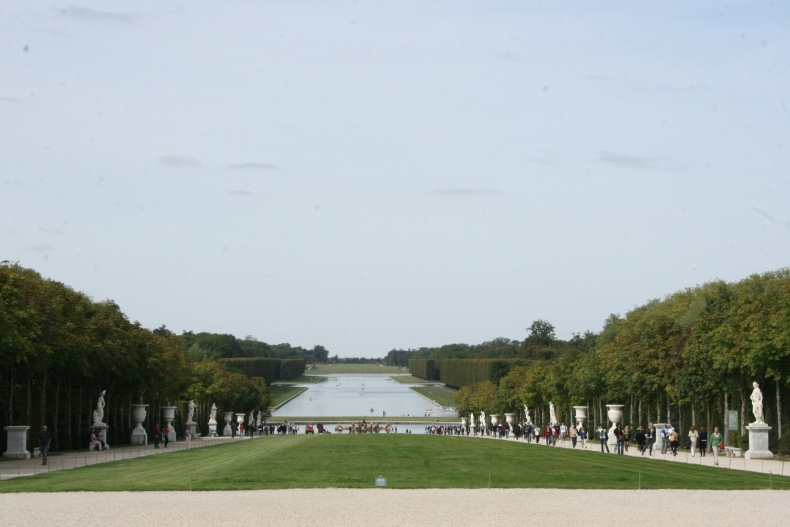
View of the Grand Canal.
In 1661, not satisfied with just plans for the renovation of the château, Louis XIV commissioned André Le Nôtre with the design and laying out of the gardens of Versailles. The works were undertaken at the same time as those for the palace and took forty years to complete. It involved complete landscaping of the existing grounds, which was mere woods, grasslands and marshes. The earth was transported in wheelbarrows, trees were brought in by carts from all over France and thousands of men were enlisted to work on this huge project.
This garden was to become Le Nôtre’s life-long work and his legacy, representing the height of French formal garden style. He was supported in this project by Jean-Baptiste Colbert, Superintendent of the King’s Buildings, Charles Le Brun, who produced drawings for a large number of statues and fountains, the architect Jules Hardouin-Mansart, who drew scenic plans and built the Orangerie.

Le Jardin.

Le jardin.

Bassin d’Apollon.
The finished product is one of indescribable elegance and beauty. Truly, it is a work of art. There are numerous references to Apollo, the Greek god of Sun, in the gardens. Known as Le Roi Soleil, or Sun King, Louis XIV was responsible for many important political, social and military reforms, which made him one of the most powerful and influential french monarchs. His love and patronage of the arts drew artisans, musicians, painters, sculptors from all over Europe to his court.
Strolling down towards the Grand Canal, we found a private little picnic spot and decided to have our lunch on one of the many garden benches, The picnic was heavenly. The sun was shining, the view was the best anyone could ask for, the simple fare of bread, cheese and ham, washed down by succulent, juicy berries and the delicate, cold bubbles of Perrier-Jouët. Mmmm… C’était parfait!! We could see the envious looks of passer-bys who were munching on their soggy, greasy pizza slices they had purchased from one of the many food vendors around the garden. There was an excursion of French school children and the school teacher, who called out a cherry ‘Bonjour’ to us, cast a lingering and approving look.
After lunch, we decided we needed to walk off our meal by trekking over to the Grand Trianon. It was a beautiful walk through tree-lined paths. There were also various cyclists about.
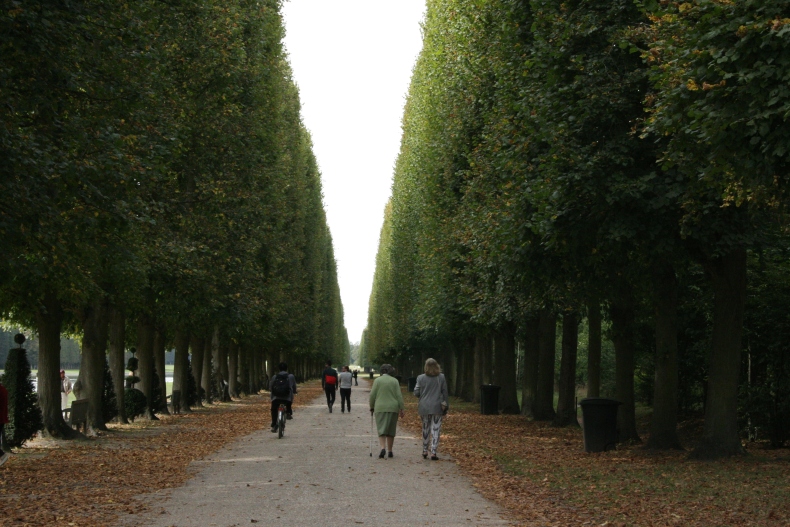
Walking through the grounds of the château.
The Grand Trianon, built in 1687 by Jules Hardouin Mansart, consists of red marble of Languedoc, and is heavily influenced by Italian-styled architecture. The Grand Trianon was the royal retreat for the king, away from the rigid, strict formalities of court-life. The rosy-pink hues of the marble, together with the orderly, geometric French-style gardens, lends the Grand Trianon a cosy but elegant ambiance.

Le Grand Trianon.
While the interior appears more relaxed compared to the grand château itself, it is no less ornately decorated. Each room is filled with beautiful chandeliers, artwork and furniture in a dazzling kaleidoscope of colours and glittering gold.

Beautiful furniture.
When we finally left the Grand Trianon, it was getting rather late in the afternoon. We realised that we would have to leave Le Petit Trianon, Le Temple de l’Amour and Le Hameau de la Reine for our next visit as we still had not yet visited the grand château. To save ourselves some time, we decided to take Le Petit Train.
Le Petit Train is a little tourist train that goes all round the grounds of the château and stops at all the major attractions. During the summer months, there’s virtually a train every 15 minutes so it’s quite handy if you’re short on time. We paid the conductor our 6.90 euro each and got on the train. We were joined by a group of rather rowdy girls and their teacher who promptly got into a disagreement with the driver as there was not enough room on the ‘train’ for all the girls. And then there was a problem with some of the girls not having their ticket stubs with them. The rules were simple – anyone who wants to take the train buys a ticket, they carry the ticket and show it to the conductor who comes around to check it before the ‘train’ leaves. The teacher, instead of setting an example of respecting the rules, decided to argue with the driver about how it was impossible to have individual tickets for each of her students. Her students, by the way, were teenagers, not children. Needless to say she was met with the usual bored, ‘I refuse to help you’ French attitude of the driver. So it was a 5 minute delay before we finally set off. On the train, the obnoxiously arrogant teacher then proceeded to complain about how the French were so difficult to get along, while a few French locals stared at her. Embarrassingly, I found out later that they were a school excursion from Methodist Ladies College, a rather exclusive private girls’ school in Sydney. Needless to say we pretended not to be Australians on that short train ride.
Heading back to the château, we deposited our bags and picked up our free audio-guide before entering. One of the first things we saw when we entered the château was the royal chapel. The present chapel is the fifth in the history of the château. Is is grand and ornately decorated, indicating the important part it played in the daily life at the royal court.

The royal chapel.

View from the Tribune Royale where the Royal Family heard mass.
There is only one way to describe the interior of Château de Versailles – complete unashamed, over the top extravagance. It is a beautiful example of the pinnacle of 18th century French art. Everywhere you look, there are beautifully painted ceiling frescoes and wonderfully gilded chandeliers.

Ceiling fresco.
La galerie des Glaces, or Hall of Mirrors is an amazingly beautiful room. Even the constant hordes of tourists who wander in and out do little to take away from its breathtaking beauty.

La galerie des Glaces.
Not just a show-stopper, the gallery’s seventy-three metres was built to signify the glory of political, economic and artistic success of France. France, under the hand of the Sun King had arrived on the world stage and they were not afraid of showing it off to the whole world. La Grande Galerie, as it was known in the 17th century was used daily by courtiers and visitors, and on special occasions for balls, weddings and diplomatic receptions. To this day, the presidents of France continue to receive official guests here. And why not flaunt it, for it is truly a spectacular sight!

La galerie des Glaces.
Moving on from the Hall of Mirrors, we came to the Royal Apartments, again sumptuously decorated.

The Queen’s Grand Apartment.
As beautiful as the surroundings were, one could not help but wonder if it was all a gilded cage. The life of the king and queen during Louis XIV’s reign was a strictly regimented routine, timed down to the last minute so that the officers could plan their work as accurately as possible. The entire day was regulated like clockwork, and consisted of rituals and customs like levée and couchée ceremonies, most of which were designed to ‘show off’ the king to the people. Click here for more detailed information on a day in the life of Louis XIV.
Leaving the Grand Appartements, we moved on to the Le Musée de l’Histoire de France. Housed in a gallery which is bigger than the Hall of Mirrors, is the entire history of France in the form of paintings, sculptures and engravings. It is a wonderful place for a history buff. There are no crowds and you can take time to sit down and take the whole place in.

Musée de l’Histoire de France.
By now, it was almost closing time. We slowly made our way out. The sun was setting and it cast an orange hue on the facade of the château.
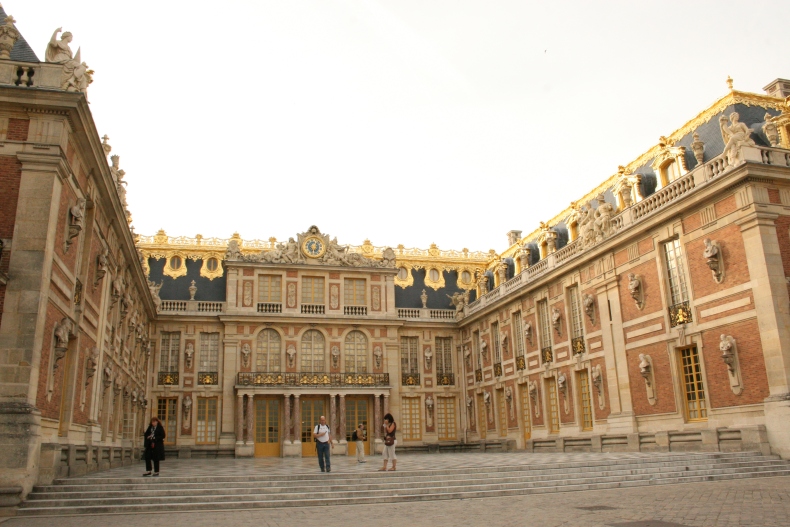
Château de Versailles in the evening sun.
We made our way back to the train station and took the train back to Paris. The activities of the day and the early morning start was beginning to get to us. We got back to our apartment to freshen up, and decided to head out for an early dinner. We decided to wander down our neighbourhood and I pulled out my list of short-listed restaurants in the 6ème that I had researched for our stay. We walked past a few that didn’t look too interested before finally arriving at Chez Fernand. It had received good reviews on TA and the menu prices looked reasonable so we decided to give it a shot. The restaurant was as we expected – noisy, tables cramped against each other and the service was typically French. We saw many locals eating here but there seemed to be equal amounts of tourists. Service was brisk and not particularly friendly. They were busy and it seemed their main goal was to turn as many tables as possible. We felt that we were hurried through our meal, a rather unusual experience in Paris, as we generally find we can usually enjoy a leisurely meal without getting the impression the wait staff wanted to get us moving along. I had the bœuf bourguignon which was tasty and well cooked but hubby’s dish was rather ordinary (he can’t remember what he had so it was rather forgettable). When we got the bill, we thought the meal was rather pricey for what we had. (To be honest, I wish we had paid the little extra and dined at a 1 Michelin star instead.) Anyhow, we had warm food in our bellies and decided to turn in for the night after a very long day.








